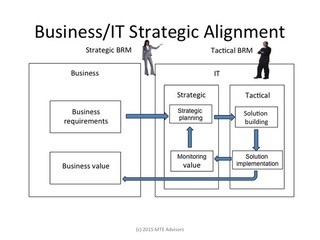Many of my consulting clients have expressed their challenges regarding business-IT alignment. However, there are many that believe the word “alignment” should be replaced with the word “convergence.” What does convergence mean? According to Webster’s definition, convergence is “the act of converging and especially moving toward union or uniformity.” When you use the word alignment, it implies that there are two separate entities trying to work together but still remaining separate. The reality is that roles/activities that were traditionally embedded in the IT are now embedded in the business. It is not merely “IT-Business Alignment” anymore. IT-Business convergence means that both entities are moving to become one unit.

Mark Edmead, IT Transformation Consultant and Trainer, MTE Advisors, mark@mteadvisors.com
Portions of this article were previously published here
So what does the business/IT relationship look like in many organizations? Figure 1 shows the visualization of the way many organizations separate business and IT. There are two distinct divisions – business on one side and IT on the other. In the business side we have the business strategic plans or business requirements. On the other side we have the IT group. This group is further divided into two separate sections: strategic and tactical.
 Figure 1
Figure 1
Are you can see, there is a visible gap between business and IT. And this is where the discontinuity or misalignment between the business and IT begins. In an ideal world the business requirements/plan drives the IT strategic plans. But it often does not. The business speaks a totally different language than IT (and conversely IT speaks a different language than the business). From the IT strategic plans come the tactical solution initiatives. Ideally this tactical solution should be driven by the IT strategic plan which in turn is driven by the business requirements. On the IT strategic side, we need to make sure we are getting value from our IT solutions. In addition, we need to make sure we are getting value on the business side. And these two values should be related. That is, if we get a perceived value from IT but not from the business then we have a problem. It means that IT is delivering solutions they think is of value to the business when in fact it is not.
So the question now becomes: “how do I close that gap?” One strategy is the use of Business Relationship Managers or BRMs. A BRM is pivotal to the convergence of IT resources to business needs. BRMs have an understanding of business processes and how IT solutions are or ca be deployed to meet the business requirements. In fact, there can be two types of BRMs. The “Strategic BRM” is positioned between the business and IT. The Strategic BRM acts as the translator, liaison, and diplomat between the two groups. Their job is the build, develop, and nurture relationships with key business and IT stakeholders. The “Tactical BRM” on the other hand assists in the coordination of application and infrastructure projects. They also interact with business management and key users to ensure they understand and are making full use of the system capabilities.
Another consideration is the language use to communicate between the business and IT can influence the type of relationship we have with them. To enable better business and IT convergence, we need to learn how to talk more like a strategic partner instead of an order taker. The industry talks about how the business and IT need to work together to achieve common organizational goals. If we truly want to achieve such convergence, we need to not only be “walking the walk” but in fact we should begin by “talking the talk.” The Business Relationship Manager (BRM) is becoming an increasingly important role in many organizations to address this very issue. A BRM can help convey the business needs to the IT department and manage business expectations. BRMs act as liaisons, ambassadors, and translators. While business relationship management might be the job of one or more dedicated BRMs, it is also the way to run a successful business. Business is a relationship—BRM is the way to foster it.
Mark Edmead is an IT transformation consultant and trainer. Over the past 28 years, he has provided IT transformation and business improvement services that align information technology with business goals to drive bottom-line performance and growth. Mark’s focus is on change management, process improvement, enterprise architecture, technology road mapping, strategic IT planning, IT organization analysis, IT portfolio management and IT governance. Mark holds a number of certifications including is Certified Business Relationship Manager (CBRM), Lean IT Professional, TOGAF 9.1 DevOps Foundation, Agile Service Manager, ISO 38500 Lead IT Corporate Governance Manager, Certified Scrum Master, and COBIT 5 Assessor. Mark has delivered numerous international workshops in countries such as United Arab Emirates, Kuwait, Japan, Hong Kong, Taiwan, Singapore, Malaysia, Switzerland, Germany, Chile, Mexico and Scotland. His past clients include BMW, Catholic Health Services, AARP, the United Nations, Kaiser Permanente, Saudi Aramco, and the U.S. Department of Defense.
Copyright Mark Edmead, MTE Advisors

